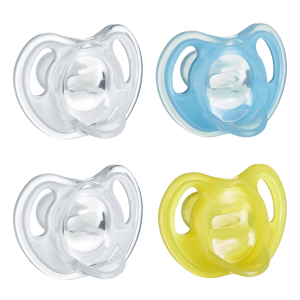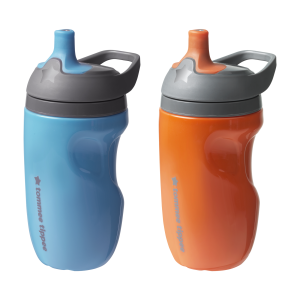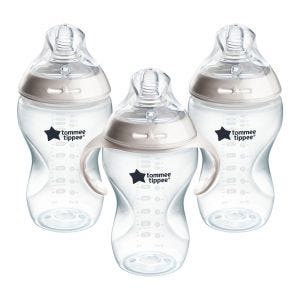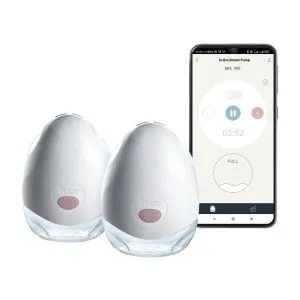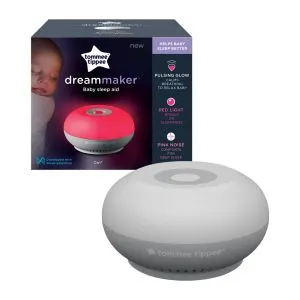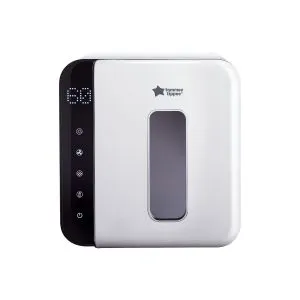
Tommee Tipps
If you're new to feeding a baby with a bottle, it can be overwhelming at first. But loads of parents use a bottle to feed their baby, whether with breast milk or formula.
A Guide to Newborn Bottle Feeding
If you're new to feeding a baby with a bottle, it can be overwhelming at first. But loads of parents use a bottle to feed their baby, whether with breast milk or formula. And once you've done it a few times, you'll feel much more confident and wonder why you were ever nervous in the first place.
To help you get started, we've written this handy step-by-step bottle feeding guide, so read on to learn more!
What equipment do you need for bottle feeding?
When you're getting ready to bottle feed, you'll need several bottles, nipples, a bottle brush, some sterilizing equipment, and perhaps a breast pump.
Head to our baby feeding glossary to learn more about what you'll need to feed.
How many bottles and nipples do I need for bottle feeding?
The number of bottles and nipples you'll need depends on how frequently you intend to use them to feed your little one.
Feeding once a day or just occasionally? You'll only need a few, at least two so that if they get lost, damaged, or unclean, you have a backup.
Exclusively bottle feeding? It's a good idea to opt for four to six bottles and nipples to get started with because newborns can feed up to 12 times over 24 hours!
How often should I check the nipples on baby bottles?
Your tiny tot's soft gums won’t stay that way forever! Soon they'll begin teething and you'll need to check your bottle nipples for signs of biting.
You should change your bottle nipples every two months or right away if they're damaged or weak.
Your baby will usually let you know when it’s time to change flow rate, or even if you’ve moved up too quickly.
You'll know that it’s time to move up a nipple flow rate if your baby:
- becoming impatient or aggravated when eating
- taking longer than 20 minutes to finish a feed
- falling asleep while feeding
- sucking hard and/or the nipple collapsing in on itself.
And the flow of the nipple you’re using may be too fast if your baby is:
- gulping or hard swallowing
- coughing or choking
- letting excess milk drip out of their mouth
- refusing to eat.
How to sterilize bottles for feeding a newborn
You should always sterilize your baby’s bottles and feeding equipment thoroughly before each use because it protects them from infections (especially while their immune system is still developing). Failure to sterilize can lead to stomach upsets like diarrhea. Anything that goes into a baby's mouth should be sterilized for the first 12 months of their life.
Before sterilizing your baby’s bottles, be sure to clean them with warm soapy water to get rid of any milk residue.
The benefits of bottle feeding
Now that we've covered the basics, let's run through some of the benefits of feeding your baby using a bottle.
Eye and skin-to-skin contact
Your baby will probably be calm and content when you're bottle feeding them, and feeds can be a really special way to bond.
Make sure that you can see your baby's face and reassure them by looking into their eyes. Maintaining eye and skin-to-skin contact releases the love hormone oxytocin and is a great way to bond with your baby while improving their non-verbal communication skills.
Non-breastfeeding parents and other key adults who spend lots of time with baby can also experience a surge of feel-good nurturing hormones. UNICEF states that skin-to-skin contact:
- relaxes baby
- regulates their heart rate and breathing
- helps them adapt to life outside the womb
- stimulates interest in feeding and digestion
- regulates their temperature
- enables colonization of the baby's skin with the mother's friendly bacteria and protects against infection.
Breastfeeding parents get a break
The non-breastfeeding parent, as well as family and close friends, get some one-on-one time. And bottle feeding also gives those who're breastfeeding some time to recover if they're struggling with nipple soreness, clogged ducts, or mastitis.
You know how much milk baby has had
This is ideal if baby needs to gain weight and you’re monitoring feeds.
Considerations when bottle feeding
- Bottle feeding can be more expensive than breastfeeding, especially if the baby requires a special type of formula.
- Formula doesn't provide the same kind of nutrients and antibodies that breast milk does.
- There's more feeding equipment to clean and sterilize.
- You need to prepare for feeds away from home and carry equipment with you.
- Some babies may have difficulty adjusting to bottle feeding and may experience digestive issues such as trapped wind, constipation, or diarrhea.
How to bottle feed a newborn
When you bottle feed your baby, you'll be feeding them expressed breast milk or formula milk, or a combination of both (but not at the same time in the same bottle).
How to make up a bottle with breast milk
If you're going to give your baby breast milk in a sterile bottle, you'll need a breast pump or to be able to express by hand, and some sterile pouches to store your expressed milk in the refrigerator or freezer.
How to make up a bottle with formula
Follow the instructions on the infant formula packaging carefully and always use sterile water that's been boiled and left to cool. It's worth noting that too much water can dilute the formula, meaning your baby won’t get the optimal amount of nutrition from their feed. On the flip side, too much formula can lead to constipation and dehydration.
H2: Top bottle feeding tips
Let's run through some helpful bottle feeding tips.
Check the milk temperature
While lots of babies like their feeds at body temperature – around 98°F – it's worth noting that not all babies need their milk to be warm. You can try them with cool milk first to see if they'll take it. This may make things easier when you're out and about.
But if your baby likes a warm bottle, test a few drops on the inside of your wrist. If it’s a comfortable temperature, you’re good to go!
Get comfortable
Make sure that your little one is in a semi-upright position while bottle feeding. When they're lying down, there's a risk of them taking in too much milk too quickly, which can lead to discomfort or even choking. So, it's best to hold your baby close to you and support their head so they can swallow and breathe comfortably.
And, to avoid any potential choking hazards, you should never leave your baby unattended while feeding with a propped-up bottle
Introduce the nipple gently
Brush the nipple against your baby's lips to stimulate their gaping or mouth-opening reflex. Once their mouth is open wide, let them draw in the nipple in their own time – just like they would when breastfeeding.
Position the bottle at a horizontal angle
Keep the bottle in a horizontal position once the nipple is in your baby’s mouth, and tip it slightly so that the milk can flow steadily. This stops them from swallowing air and means that they need to suck to get the milk like they would when breastfeeding.
You should always tilt the bottle, so the nipple is full of milk, and as the bottle drains, you’ll need to gradually tip it higher.
If the nipple gets blocked, replace it with another sterile one and if it goes flat while you're feeding, gently release baby's latch to break the suction, then encourage them to re-latch.
Comfort your baby by talking and singing
Talking and singing to your little one while bottle feeding calms them and can help to forge a powerful emotional bond.
Follow your baby’s cues
It's best to follow your baby's lead when bottle feeding. Feeding can be tiring for babies, so watch them carefully and look out for cues that signal that they need a break. These signs will be different from one baby to the next but can include splaying their fingers and toes, wrinkling their forehead, spilling milk out of their mouth, turning their head away, or pushing the bottle away.
Feed them when they seem hungry and give them plenty of breaks – this is often called paced bottle feeding. Don’t worry if they don’t finish their full bottle. Your baby will know how much milk they need, and some want to feed more often than others.
Throw away any milk you don’t use
It’s best to dispose of any leftover milk after bottle feeding. It may seem wasteful, but bacteria can get into the milk while they feed and damage their delicate immune system. So, it's an important thing to do to keep your baby safe.
Bottle feeding: Parents' stories
Looking back Gianni believes that "the truth about bottle feeding, is that it's ok. Regardless of if you nurse directly, pump, and feed using a bottle or formula feed, it is ok. If your baby is healthy, growing, and thriving, it is ok."
And Sarah told us that "the truth is, bottle feeding allowed [her] to build a bond with [her] daughter. [Her] wife breastfeeds her, and [she] takes the opportunity every evening to feed her using a bottle to have some extra one-on-one time."
How often should I be bottle feeding my newborn?
The truth is, the frequency of feeds a baby needs varies because no two babies are the same. But generally, it’s recommended that newborns feed little and often. Try to look out for your baby’s hunger cues and feed them before they start crying.
How do I know my baby has had enough milk?
If you're wondering whether or not your baby has had enough, you can gently remove the nipple and bring the bottle down to cut off the flow of milk until they ask for more milk. If they don’t ask for more, they've probably had enough for now.
Overfeeding can cause distress and trying to bottle feed a crying baby means they could potentially choke. So, try not to make the mistake of assuming that your baby is hungry every time they cry. Other reasons your baby might be crying can include:
- needing to be burped
- needing their nappy changed
- being tired or generally irritable
- needing comfort and cuddles.
How to get a breastfed baby to take a bottle
Many parents of breastfed babies choose to introduce a bottle alongside or to replace direct breastfeeding at some point in their infant feeding journey. It’s a very personal choice that should be guided by what's best for both parent and baby.
If you've previously been breastfeeding and want to introduce bottle feeds, it can help to let your little one familiarize themselves with the feel of the silicone nipple before you bottle feed them for the first time. Be patient and don’t be tempted to force them as this may lead to them refusing the bottle altogether.
Bottle feeding FAQs
Is bottle feeding ok for newborns?
Although the U.S. Dietary Guidelines for Americans recommends exclusive breastfeeding for the first six months of life, the decision to bottle feed or breastfeed is a personal choice. And babies can be bottle fed from birth if they're unable to breastfeed or you choose not to for whatever reason.
Whichever feeding method you choose, the decision should be made in consultation with a healthcare provider.
Can you overfeed a newborn?
Although rare, it’s possible to overfeed a bottle-fed baby. Read our dedicated guide about overfeeding a baby to learn how to prevent it.
Why is my newborn still hungry after feeding?
If your newborn is still hungry after feeding, they may be ready to move on to a larger feed, or they may be cluster feeding. It's also possible that they have a medical issue that's affecting their appetite. It's always a good idea to talk to your pediatrician or midwife if you have any concerns about your baby's feeding habits.
How do I wind my baby after bottle feeding
If your baby seems uncomfortable during or after a feed, spending a few moments burping them can help to relieve discomfort caused by trapped wind. Signs of trapped wind include:
- crying
- arching their back
- drawing their legs towards their body
- clenching their fists.
You can burp your baby over your should, sitting on your lap, or lying across your lap. Some parents also find that lying them on their back and gently massaging their tummy and moving their legs forward and backward helps.
Are Tommee Tippee bottles suitable for newborns?
Yes, Tommee Tippee bottles are suitable for newborn babies.
Sources

